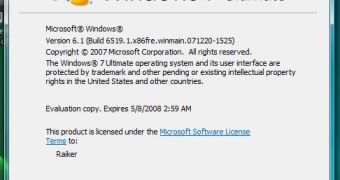Windows 7, the successor of Windows Vista, but also of Windows Server 2008, in the form of Windows 7 Server, had been under development over at Microsoft under the lead of Steven Sinofsky, Senior Vice President, Windows and Windows Live Engineering Group since 2007. At the end of 2007, the Redmond company made available Windows 7 Milestone 1 to a select group of partners. However, under Sinofsky, translucency is the new communications policy of the Windows team, and little details are indeed made public, or even leaked. This is why there are aspects of the next iteration of Windows which fail to be in conformity with the little transparency Microsoft did manage to offer on Windows 7.
1. The Windows 7 Kernel - After it played hide and seek with the MinWin kernel, Microsoft has managed to create a consistent level of confusion related to the core of Vista's successor. It seems to be unclear whether Windows 7 will feature MinWin, or a new kernel, or the same old kernel as Windows Vista. Well, it's rather simple. First off, there was never talk of a completely new, built from scratch kernel. And MinWin wasn't really the kernel, but the core of Windows 7. Which essentially means that Microsoft has taken the existing kernel plus a series of core components and worked to slim them down.
What the Redmond giant is doing is mainly to continue the evolution of Windows Server 2008, as far as the core of the operating system is concerned. The core of Vista's successor is an evolution of what is available today, and is a new major version of the kernel, hence the Windows 7 label. And yes, Windows Vista was the sixth version of Windows, but Microsoft is only counting from kernel version to kernel version and not from one Windows release to the other.
2. The Myth of the Complete Overhaul - Some want Windows 7 to be written from scratch, arguing that Microsoft needs to flush down Vista, Windows XP, and all past Windows versions, and start over. Such a scenario is argued to be the sole solution to save Microsoft. And at the same time this is impossible. Windows 7 will not be built from scratch because it simply can't be. Windows Vista had serious problems when it came down to application and hardware incompatibility and lack of driver support.
Now imagine a brand new and shiny Windows 7, with no connection to any previous versions of Windows. Nothing would work. Nothing! Not your programs, not your hardware, nothing. The truth is that neither Microsoft, nor the environment of hardware and software developers depending on the Windows as a platform, and not even end users can afford, or are ready to deal with a complete overhaul.
3. Windows Vista R2 - Because of the fact that Microsoft has indicated that Windows 7 would be using Vista as its foundation, critics have already started to emerge labeling it Windows Vista Release 2. No one, with the exception of Sinofsky of course and the Windows project, knows what Windows 7 will end up as. To jump the gun and start throwing dirt at it even before the first beta is on the horizon is simply an indication of people waiting for Microsoft to fail. And although the company did not disappoint them in the past, criticism should be postponed until a palpable build of Windows 7 hits.
4. One SKU to Rule Them All - There is increasing feedback pointing to the need for Microsoft to simplify the edition bonanza of Windows 7, and to avoid offering the same SKU richness as it did with Windows Vista. Windows Vista Starter, Home Basic, Home Premium, Business, Enterprise, Ultimate are just the start of it. There are also N variants for Europe and upgrade packages. However, the Redmond company knows that a single SKU is not the way to go. While simplification is indeed necessary, copying the Mac OS X model is not the right solution to offer a balance to both home and business users. And even with Windows Vista, all SKUs ship on a single install media, but the actual installation is governed by the license key.
5. The Silence is Deafening - The latest misunderstood aspect is on the other side of the barricade, so to speak. The silence around Windows 7 is deafening. Sure enough, Microsoft did manage to offer a few details about the touch computing capabilities coming, and is bound to share more at PDC2008 - Professional Developers Conference between October 27-30, 2008. But Microsoft needs to understand that while saying too much about Windows Vista has hurt that release, saying nothing about Windows 7 will hurt this one. And after Vista, I'm not sure if the company can afford another slip...

 14 DAY TRIAL //
14 DAY TRIAL //